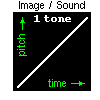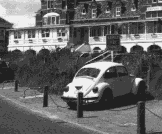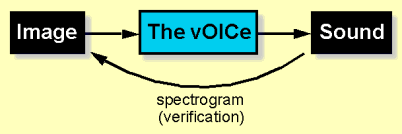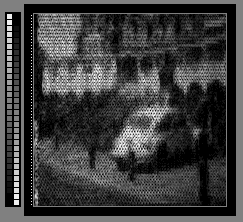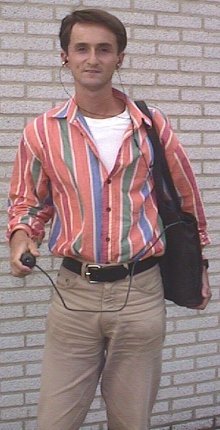
Auditory display for synthetic vision
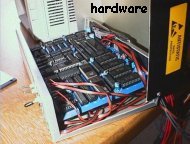
The vOICe hardware prototype
|
Originally, a hardware prototype, nick-named The vOICe
(OIC? Oh I see!), was developed to prove the technical feasibility of the underlying concepts. It starts
by subdividing an electronic photograph into 64 rows and 64 columns, giving 4096 pixels.
Shading is reduced to 16 levels of grey.
Column by column, the image is then
translated into sound. The top pixel in a column gives a high pitch, and the
bottom pixel a low pitch. An intermediate position gives an intermediate pitch.
The grey-level is expressed by loudness. All pixels in a single column are
heard simultaneously, much like a musical chord. With subsequent image columns,
these chords change according to the pixel brightness distribution within the column.
In this way, the image content is translated into sound by scanning through all
64 columns, from left to right. Finally, a click marks the beginning of a new
image. Typically, fresh electronic photographs are taken and converted into
sound at one-second intervals. Of course, there is a lot more to be said about
technical issues relating to this general image-to-sound
mapping for artificial vision.
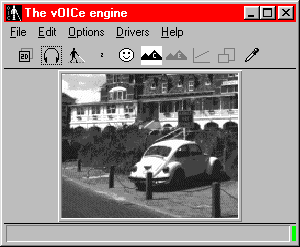
The vOICe software
|
Very important for a good mapping is the concept of preservation
of simplicity and similarity: simple images should sound simple,
and simple shifts in position should lead to correspondingly simple
perceptual changes in the sounds. Complexity should not arise from the
mapping itself, but only from the complexity of the content
of the image being mapped into sound! Furthermore, the mapping should
not only allow one to distinguish different image sounds and
to learn to associate a given set of auditory patterns with
their visual counterparts, but also to analyze and
generalize them for situations that were not in the training
examples.
The vOICe hardware did not become available as a product. However,
in the photograph on the left, a software
version of The vOICe is being used, running on a fast Pentium notebook
PC (inside the shoulder bag) with a PC camera and headphones. This software
is available and now lets you experience The vOICe yourself
using The vOICe for Windows for
Microsoft Windows. Try it!
|





